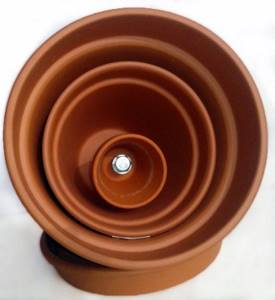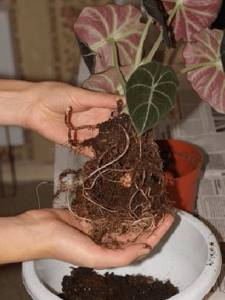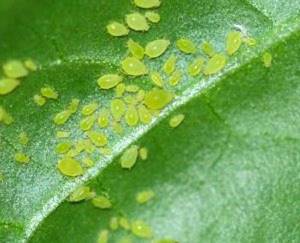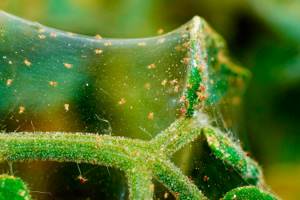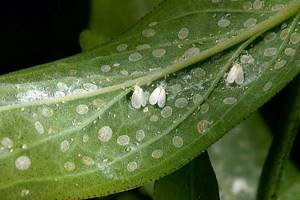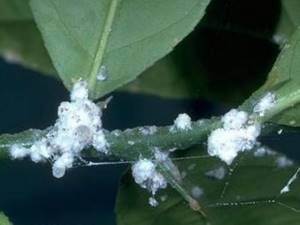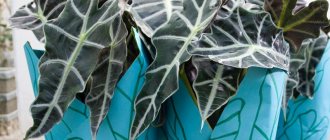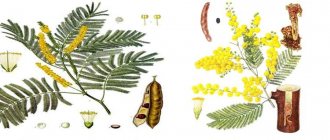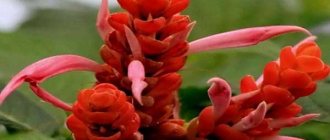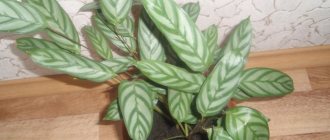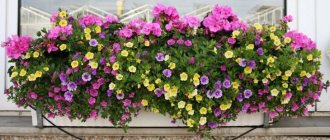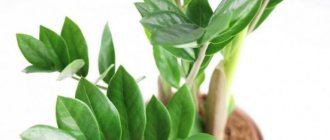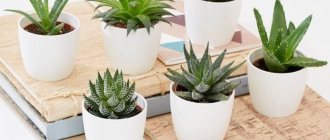What does alocasia look like and what is it?
This is what alocasia looks like in nature
Alocasia is one of the most beautiful representatives of the Araceae family. This perennial plant is distinguished by its large leaves with a glossy surface, thanks to which the flower is popularly called “elephant’s ear.” They are shaped like a heart with pointed corners and curly edges. There are from 4 to 8 leaves on one bush.
When the fourth leaf appears on alocasia, the process of dying off of the old leaf plates begins. Because of this feature, the plant is called trefoil.
In nature, alocasia blooms, and during this period large pinkish, yellow or greenish flowers appear. Since in nature this plant grows in the tropics, it has a specific feature, which is the ability to release excess moisture through the surface of the leaves.
What types of Alocasia are there?
Alocasia is an evergreen plant. Its main advantage lies in its large leaves, decorated with a pattern of veins. Their length ranges from 20 to 100 cm. The leaf blade can have a wide variety of shapes, from oval to heart-shaped. Its edges can be smooth or with convex ribs. The color is predominantly dark green, and their surface shines, as if covered with varnish.
Alocasia blooms quite rarely. A yellowish or white ear appears on a peduncle with a dense structure. Initially, the inflorescence is almost hidden by a scroll, which unfolds as the berries with several seeds ripen. It is worth noting that during flowering, leaf growth practically stops. In addition, they may completely or partially fall off. Therefore, most flora lovers initially prune the gardener, because the main decoration of the tropical beauty is the leaves.
Important! Alocasia is a poisonous plant. Its juice causes severe irritation if it comes into contact with the skin.
At the same time, due to the content of essential oils in it, it is widely used in medicine for making ointments against joint pain. Photos of the varieties are in the article.

Popular types with photos
There are about 80 species of alocasia, differing in the variety of leaves and sizes. Miniature varieties reach 15-75 cm in height, and large ones - 1-3 m.
Small plants are more suitable for decorating window sills in small-sized urban apartments, and tall alocasias are more suitable for growing in country cottages. Among the varieties of this plant there are also decorative specimens with non-standard color and leaf shape.
Miniature varieties
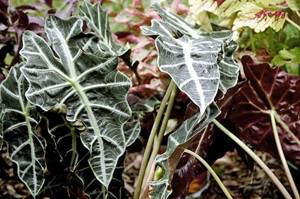
Polly
The most popular miniature variety among gardeners is Alocasia Polly, reaching a height of no more than 65 cm. This variety is one of the most unpretentious, since it tolerates lack of lighting more easily than others.
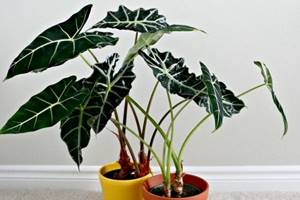
Sandera
Alocasia Sander reaches a height of about 60 cm. The plant stands out for its dark green leaves with curly edges and white veins.

Amazonian
Amazonian alocasia, or Amazonica, is an even smaller variety of Sandera and is about 50 cm high. Its distinctive feature is the smooth edges of the leaves, without denticles.

Bambino
Another miniature variety of alocasia is Bambino, which reaches 40 cm. This flower has narrow long leaves with pointed tips.
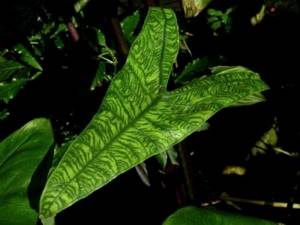
Zebrina
The largest among the presented small varieties of alocasia is Zebrina, reaching a height of 75 cm. The peculiarity of this variety is its light green triangular leaf plates, which contain not only veins, but also an unusual pattern.
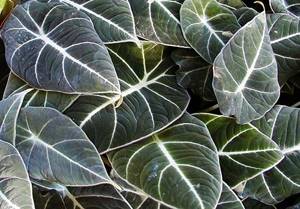
Black Velvet
The smallest variety of alocasia is Black Velvet, which is no higher than 40 cm. The leaves, which resemble velvet in texture, are colored pinkish on the inside, and dark green, almost black, on the outside.
Large plants

Large-rooted alocasia
The largest variety of this plant is the large-rhizome or large-rooted alocasia, also called Macrocrisis. It reaches a height of 2 m and has large shiny salad-colored leaves with white spots.
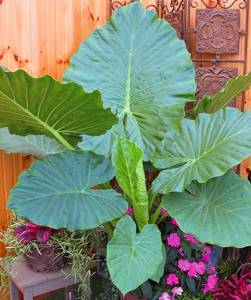
Kalidora
Another species, whose height varies from 1 to 2 m, is called Alocasia Kalidora. The dark green dense leaves of the plant without pronounced veins are arranged vertically and often reach a meter in height.

Venti
Alocasia Venti is distinguished by oblong leaves of a gray-green hue with a pronounced silver tint and a purple inner side. This plant reaches a height of no more than 1.2 m.

Klobuchkovaya
The cap alocasia grows up to 1 m and has rich green leaves with raised veins.
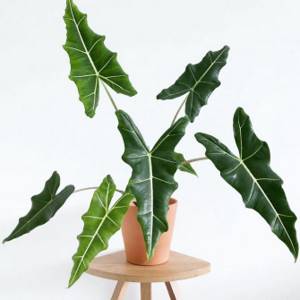
Sarian
Alocasia Sarian also reaches no more than 1 m in height. The plant stands out for its dense, smooth leaf blades with jagged, curly edges, white veins and sharp tips.

The Dragon
Alocasia Dragon, or Dragon Scale, is considered one of the most decorative and popular varieties due to its unusual textured leaves. Compared to other large varieties, it has modest dimensions, since it rarely reaches 1 m in height.

Copper red alocasia
Copper-red alocasia, or Red Secret, is the most indoor-adapted species, distinguished by glossy greenish-copper leaves with dark green veins and poisonous sap. Its height is no more than 1 m.
Landing
To plant alocasia, you need to prepare the soil, which you can make yourself or buy in a store. To make it at home you will need the following components:
- 4 parts each of leaf, coniferous soil and peat;
- 1 part each of coarse sand and crushed sphagnum moss;
- a little perlite.
All components should be mixed thoroughly. For large varieties and plants older than 3 years, it is necessary to add 1 part of humus mixed with soil to the soil.
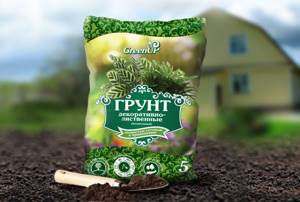
It is advisable for beginning gardeners to purchase a ready-made complex soil mixture for decorative foliage plants. If you use hard water when watering, it is recommended to buy a more acidic soil, which is intended for azaleas and hydrangeas.
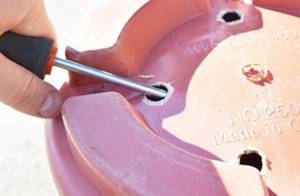
For alocasia, you need to choose a large and deep pot with drainage holes. It is advisable that the container be made of ceramic. If there are no holes for drainage in the pot, you can make them yourself using a screwdriver.
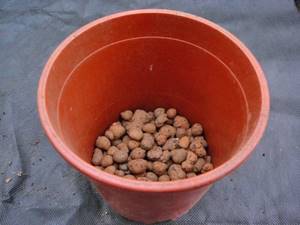
Drainage
The soil for alocasia should be well-drained. Before planting, you need to lay out a layer of drainage on the bottom of the selected pot, for which you should use pebbles, expanded clay or crushed stone.
Recent Entries
Chainsaw or electric saw - what to choose for the garden? 4 mistakes when growing tomatoes in pots that almost all housewives make Secrets of growing seedlings from the Japanese, who are very sensitive to the soil
Containment conditions: table
When grown in an apartment, this tropical plant must be provided with conditions depending on the season.
| Season | Lighting | Optimal temperature conditions | Humidity level | Accommodation |
| Spring Summer Autumn | The plant requires a lot of light, but it is advisable to shade it slightly to prevent yellowing of the leaves. In this case, the flower should be protected from direct sunlight. | The temperature should be within +21… 26°C | It is necessary to provide a high level of humidity and spray the plant once every 3 days. On hot days, the procedure should be carried out daily | Window sill facing west or east |
| Winter | Varieties with variegated leaves require additional 2-hour artificial lighting | Minimum temperature – +18 °C | Keep the level high, but reduce the frequency of spraying to 1 per week. If the room is stuffy, then it is advisable to carry out the procedure more often (2-3 times a week) | South window |
Since the flower is sensitive to sudden temperature changes, the pot with alocasia must be protected from drafts and not kept near heating devices in winter.
What is it: description and photo
It is a plant of the Araceae family, growing naturally in tropical climates , with a height ranging from 30 centimeters to 2 meters. The stem is erect, herbaceous, the longer it grows, the thicker and denser it becomes.
The leaves are large, petiolate, have prominent yellow or white veins, depending on the plant species, and may be oval, heart-shaped, or shield-shaped. The leaf blade is cut, smooth to the touch, dense, resembling leather. Leaves can be of different sizes, from 20 centimeters to 1 meter. It has a short rhizome in the form of tubers, or stolons.
The flower is located on an erect short stalk, and looks like a spike-shaped inflorescence, with a fleshy axis, which has many small sessile small flowers, covered with a veil, much larger than the flower itself, and with a strong odor.
It grows in countries with a tropical climate, India, Malaysia, Asian countries, Latin America, and eastern Australia.
The plant took root as a houseplant not long ago. It first came to Russian expanses as an ornamental plant for the winter garden of Empress Catherine II, since the plant often released droplets of dew before rain, it began to be used as a kind of barometer.
The sap of the plant contains poison, so it should be handled with care , as sap that gets on the skin can cause severe irritation.
Features of care
Caring for alocasia at home includes the following procedures:
- proper watering;
- timely application of fertilizers;
- transfer.
Additionally, it is also necessary to trim the resulting flower stalks, since at this time the alocasia is actively shedding its leaves. The cut area should be sprinkled with charcoal powder. You can let the plant bloom, but in this case it is necessary to cut off the peduncle immediately after the end of the flowering period, so as not to further deplete the alocasia by ripening the berries.
Alocasia does not need pruning.
Watering
In spring and summer, alocasia needs abundant and regular watering. It is recommended to moisten the soil as the top layer dries out. The water from the pan must be poured out without allowing it to stagnate. Boiled water at room temperature is suitable for watering alocasia.
In winter, you need to water the flower no more than twice a week. If the pot with alocasia is located in a cool room, the soil should be dried a little so that the roots do not begin to rot. In winter, it is recommended to water the plant with warm water.
Top dressing
In spring and summer, the flower must be fed once every 3 weeks. As a fertilizer, it is recommended to use an organic or mineral mixture intended for indoor plants. It is desirable that the fertilizer contains nitrogen and potassium.

You can alternate the “Leaf” fertilizer (1 tbsp per 3 liters of water) with “Agricola for ornamental leafy plants” (1 tsp per 3 liters of water). In autumn and winter, the frequency of fertilizing should be reduced to once every 6 weeks.
Transplantation: instructions with photos
Young plants need annual replanting. It is recommended to carry it out in the spring. It is enough to transplant adult specimens into a larger pot once every 3 years.
Consecutive transplantation of alocasia is carried out as follows:
| Step number | Actions | Photo |
| 1 | Choose a container whose diameter will be approximately 3 cm larger |
|
| 2 | Pour drainage into the selected pot |
|
| 3 | Add prepared soil on top |
|
| 4 | Remove the plant from the previous container, carefully holding the top of the soil and the flower stem with your fingers |
|
| 5 | Shake off the crumbling soil, being careful not to damage the root system |
|
| 6 | Place the plant in the center of the pot, gradually add new soil around the roots and lightly compact the soil |
|
After replanting is completed, the plant must be watered generously and the water accumulated in the pan must be removed after 2 hours. It is recommended to carry out the procedure with gloves, since the juice of many varieties of alocasia is poisonous.
How to transplant alocasia
Young alocasia grows quite quickly, so plants under 3 years of age need annual replanting. Further, the procedure is carried out as necessary - every 2-3 years. It is best to replant a flower in early March, when the active growing season has not yet begun.
A new pot is selected so that its diameter exceeds the previous one by 2–3 cm . It must be massive and stable. The preferred materials are unglazed ceramics - they are heavy and allow air to pass through. Choose containers that are shaped like a bucket.
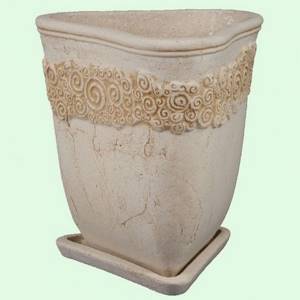
A pot for alocasia must be massive, deep and stable
Alocasia prefers light, slightly acidic soil with good drainage. When buying soil in a store, check the acid-base balance. If the soil is acidic, add crushed chalk (about 50 g per liter of soil). If you have the opposite problem, use soil for azaleas (in a ratio of 1:5). Acidity is determined using strips of indicator paper; instructions for use are included in the kit.
The soil mixture can be like this:
- substrate for aroids;
- universal soil for decorative foliage plants and drainage - sand, coal, perlite, sphagnum or coconut fiber (4:1);
- rotted leaves, pine needles, peat chips and sand (1: 1: 1: 0.5).
Alocasia juice causes irritation and allergic reactions on the skin, so proceed with transplantation only with rubber gloves, and wash your hands after the procedure.
Transplant process:
- Fill a quarter of the volume of the new pot with drainage.
- Sprinkle about 2–3 cm of substrate on top. Lightly moisten it.
- Tap the walls of the old container and carefully remove the plant.
- Without destroying the earthen ball, move the alocasia to a new pot and add soil.
Make sure that the root collar does not end up in the soil.
- The substrate is moistened again, the pot is placed in its original place.
Boarding after purchase
Alocasia purchased in a store needs to be replanted within 3–4 days, completely replacing the transport soil.
Progress:
- The pot is lowered into a container of water so that it completely covers the soil.
- After 10–15 minutes, the flower is removed from the substrate, the remaining soil is washed off with water and several crystals of potassium permanganate.
- Rotten, dried roots are cut off with a well-sharpened, disinfected knife. The cut areas are sprinkled with crushed chalk or activated carbon powder. The roots are dried for an hour.
- The plant is placed in a new pot and watered abundantly.
Reproduction methods
Alocasia can be propagated at home in several ways:
- dividing the rhizome;
- planting tubers;
- cuttings.
Seed propagation is not used, since alocasia blooms extremely rarely. In addition, the varietal characteristics of the plant are not preserved, and it is possible to grow a flower in this way only after a year.
Rhizome division
This method of reproduction is the easiest to perform. An adult plant produces daughter flowers with independent roots, which can be replanted during spring transplantation.
Propagation by dividing the rhizome must be carried out as follows:
- Carefully remove the entire earthen lump from the container.
- Wash the soil from the root system.
- Separate the shoots using a sharp, disinfected knife.
- Sprinkle the cut areas with crushed coal.
- Plant the shoots in separate pots.
Tuber planting
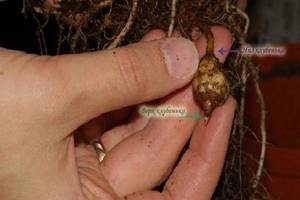
Propagation of alocasia by planting tubers is also carried out in stages. Procedure:
- Remove the plant from the pot.
- Wash the soil from the root system.
- Separate the tubers formed on the roots using a sharp knife.
- Treat the cut areas with charcoal powder.
- Deepen the tubers into the sphagnum moss by about 2 cm (the top should be visible).
- Moisten the soil and cover the plant with film or a jar.
The containers must be placed in a warm room and the plants must be provided with sufficient lighting without exposing them to direct sunlight. The first shoots, as a rule, appear after 3 weeks.
Cuttings
This method of reproduction is used extremely rarely. Most often they resort to it if the alocasia has been damaged. Cuttings should be carried out as follows:
- Split the broken alocasia stem.
- Cut it into pieces (each piece should have 1-2 buds).
- Bury the plant in the sand-peat mixture by 1-2 cm.
- Moisten the soil.
- Cover the plantings with jars or film.
The plantings should be ventilated daily, removing the cover for 10 minutes. It is necessary to maintain high humidity in the room and ensure that the temperature does not fall below +23°C.

Plant ready for transplanting
As soon as the plant takes root, the greenhouse must be removed. You can replant the alocasia into a pot after 1-2 leaves appear.
Alocasia sanderiana
This species is distinguished by the largest leaves, the surface of which is covered with snow-white veins that form a pattern on them. The roots are tuberous and short. The leaf blade has an elongated triangular shape. Culture is valued for its decorative value. Belongs to perennial herbaceous plants, belongs to the genus Alocasia and the Araceae family. The height of the shrub can be up to 75 centimeters. The leaves are attached to long petioles and are formed in one bunch of 3-5 pieces. The petioles are glossy, rich green in color. The length of the petiole is 15-80 cm. It blooms with single flowers, which are held on green pedicels about 18 cm long. The pedicel in the initial stage has a vertical shape, after a while it bends. The flower has a spathe about 10 cm long and an ear of the same length. The leaves are semi-round. At the end of flowering, elliptical fruits up to 4 cm long and red-orange in color are formed. Fruit circumference 75mm. This culture can often be found in the tropics of Asia, in evergreen forests and on granite rocks. Prefers to be grown in shady places with high humidity and frequent watering.

Growing problems: table of signs and remedies
Problems may arise when growing this tropical flower, but most often they appear if the alocasia has not been provided with proper care.
| Problem | Reasons for appearance | Ways to correct the situation |
| Leaf wilt |
| Replant the plant and provide it with proper watering |
| Drying of the edges of the tips of the leaves | Dry indoor air | Use a spray bottle to humidify the air more often |
| Growth slowdown | Nitrogen deficiency | Feed the plant with nitrogen-containing fertilizer. Dosage – 1 g per 1 liter of water |
| Yellowing of leaves |
| Move the pot with alocasia to a room protected from drafts. Water the plant only with boiled water |
| The appearance of dark spots on the leaves |
| Shade the flower and move the pot to a warm room |
| Dropping leaves |
| The peduncle must be removed and the plant fed with complex fertilizer |
| Fading of sheet plates | Insufficient lighting | Provide alocasia with additional artificial lighting |
| The appearance of water drops on the leaves | Excess moisture | Drain the water from the pan and let the soil surface dry |
Diseases and pests: photos and control measures
The tropical flower is susceptible to attacks by pests, which most often enter the room through open windows. In some cases, parasites live in the soil, and when alocasia is planted in such soil, infection immediately occurs.
| Parasite | Signs of infection | Recommendations for troubleshooting the problem | Pest image |
| Aphid |
| Spray the leaves with a solution consisting of equal parts soap and oil. Treat the plant with Fitoverm. Insecticide dosage – 4 ml per 1 liter of water |
|
| Spider mite |
| Treatment with Actellik (2 ml per 2 liters of water). You can also spray alocasia with a soap-tobacco solution 2 times a week. |
|
| Whitefly | The appearance of small flying insects on platinum leaves | A single treatment with Confidor is sufficient. Dosage of the drug – 0.1 ml per 1 liter of water |
|
| Shchitovka | Formation of small brownish tubercles tightly attached to alocasia | Wash off the pests with a soap solution (15 g of liquid soap per 1 liter of water), in which you need to moisten a sponge. Then treat the leaves and soil surfaces with Aktara (0.8 g per 1 liter of water) |
|
| Mealybug | The appearance of a white substance similar to cotton wool, which is secreted by scale insects, | Soak a cotton pad in calendula tincture and wipe the affected leaves. Treat with soap solution three times (15 g per 1 liter of water), after a weekly interval. Treat with Aktara (0.8 g per 1 liter of water) in the same mode |
|
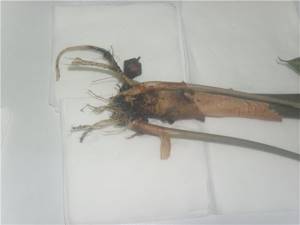
Root rot
Improper care can lead to the development of diseases in alocasia. Most often, this plant suffers from root rot due to excessive watering. A sick flower stops growing, and its leaves gradually wither, become deformed and fall off. You can cure alocasia as follows:
- Remove from pot.
- Remove affected rhizomes.
- Treat the root system with copper sulfate (1 tsp per 2 liters of water).
- Transplant the flower into a new pot.
